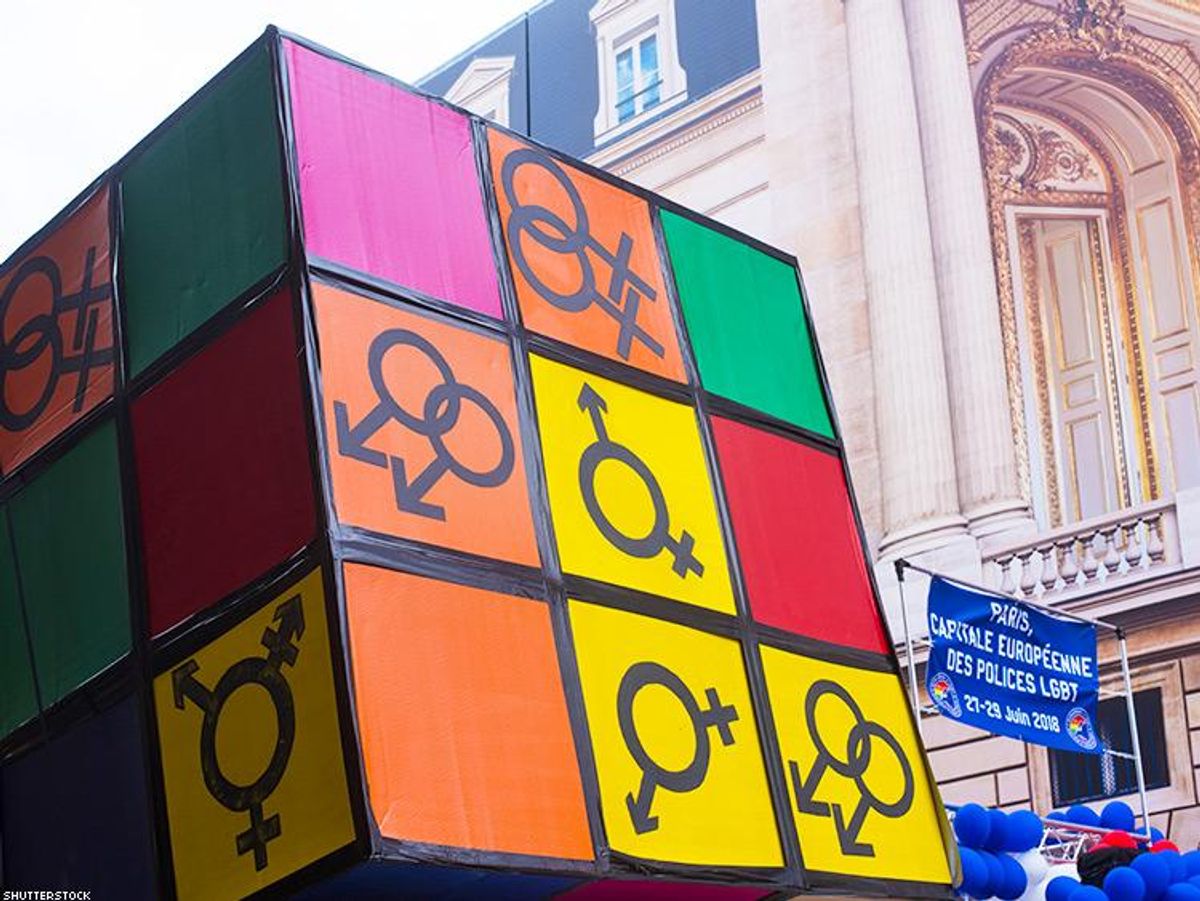Current Issue
A 101 Guide to Knowing Thyself (And Understanding Everyone Else)

Our 101 guide to gender identities and sexual orientations.
Rahel Neirene and Jacob Anderson-Minshall
September 04 2017 1:53 PM EST
May 26 2023 1:51 PM EST
By continuing to use our site, you agree to our Private Policy and Terms of Use.

Our 101 guide to gender identities and sexual orientations.
Where society once only recognized homosexuality and heterosexuality, there's a growing awareness of -- and terms for -- a much larger, ever-expanding galaxy of sexual orientations. The same can be said for genders: While many only recognized male and female, and masculinity and femininity, we are witnessing an explosion of terms and identities, often coined by those who find "LGBT" too narrow. Many of these other labels have been around for decades or longer, but are only gaining broader attention now. Here's a short guide to our fabulous new world.
SEXUALITY:
Beyond gay, lesbian, or straight.
Androsexual: Someone attracted to masculinity, whether in men, women, or others.
Asexuality: An orientation characterized by an absence of sexual attraction or desire for partnered sex. Asexuality is different from celibacy. Some asexual people do have sex and/or masturbate. There are many ways of being asexual.
Bisexual: Someone attracted, romantically and/or sexually, to people of more than one sex or gender. Their identity remains bisexual no matter who they are in a relationship with -- their orientation does not vacillate from gay to straight based on the gender of their current partner.
Celibacy: Chosen abstention from sex. People of all sexual orientations can practice celibacy.
Demisexual: Someone who can only experience sexual attraction after forming an emotional bond.
Graysexual: Someone whose sexuality is between absolute asexual and sexual.
Gynesexual: An attraction to females or femininity, the latter in women, men, or others.
Heteromantic: A person with a romantic, but not necessarily sexual, attraction to members of another sex or gender.
Panromantic: A person who has romantic, but not necessarily sexual, attractions to people of all genders and sexes.
Pansexual/Omnisexual: Those who have or are open to having romantic, sexual, or affectional desire for people of all genders and sexes, including those who are trans or intersex. (Many bi people identify with this definition as well.)
Polyamory (or Poly): Being in or being open to having romantic relationships with more than one person at a time, generally with the knowledge and consent of their partners.
Polysexual: Attraction to multiple genders or forms of gender expression, but not all.
Queer: Nonconforming sexual attraction, may include to those who are trans or gender variant.
GENDERS:
Beyond male/female and masculine/feminine.
Agender: Having no gender identity, or having a gender identity that is neutral.
Androgynous or androgyne: Having a gender identity or expression that includes both masculine and feminine elements, often to the point where one's gender isn't readily apparent to others.
Bigender: Having two gender identities, which may be experienced simultaneously or at separate times. According to the Center for Sexual Pleasure and Health, which runs an "Identity a Day" online education series, "The two genders may be male and female, but they might also include other nonbinary gender identities."
Gender Fluid: When one's gender identification or presentation shifts between two or more genders.
Gender Nonconforming: Gender expressions or roles that are outside those expected by society. They're not confined by conventional definitions of male and female, and can include people who identify as trans or genderqueer.
Genderqueer: A person whose gender identity or gender expression falls outside of the dominant societal expectation for their assigned sex, is beyond genders, or is some combination of them.
Gender Variant: Varying from the expected characteristics of one's assigned gender or sex.
Intersex: Those who have a variety of conditions in which a person is born with a reproductive or sexual anatomy that doesn't fit medical definitions of female or male. This happens in around one in every 1,500 to 2,000 births, according to the Intersex Society of North America, making it about as common as red hair. An intersex person might be born appearing female but with male chromosomes or internal anatomy, or born with genitals that seem outside defined male and female types. Many who are intersex have been forced, as children, to undergo surgeries that attempt to make their sexual organs conform to medical expectations. They may identify as intersex, male or female, or any of the other gender IDs here.
Neutrois: Similar to agender -- a neutral or even genderless identity.
Trans or Transgender: This has become somewhat of an umbrella term for anyone with any type of gender variance. But for some it is more specific, representing those who identify or express a gender at opposition with the gender they were assigned at birth. While some trans people merely alter their identification or external expression, others pursue medical interventions like hormone treatment and gender affirmation surgeries. People who are trans often identify as either male or female, but may not do so.
Transsexual: A gender identity that is generally specific to those who are trans and undergo medical intervention to transition from the sex (male or female) they were assigned at birth to the sex they identify as being authentically. Transsexuals often view gender as binary, identify as male or female, and may accept more traditional gender roles.
Two-Spirit: A person of Native American descent whose body simultaneously houses both a masculine spirit and a feminine spirit. As an umbrella term, it may encompass same-sex attraction and a wide variety of gender variance, including people who might be described as queer, gay, lesbian, bisexual, trans, genderqueer, or having multiple gender identities.
Of course there are also dozens of micro-identities too, like subcategories of gay men (bears, twinks) or lesbians (AGGs, femmes -- and others detailed at bit.ly/20LezIDs).
Created with input from the Center for Sexual Pleasure and Health (TheCSPH.org), which addresses physical, emotional, and mental needs related to sexual health. What did we miss? What did we get wrong? Share your thoughts @TheAdvocateMag.